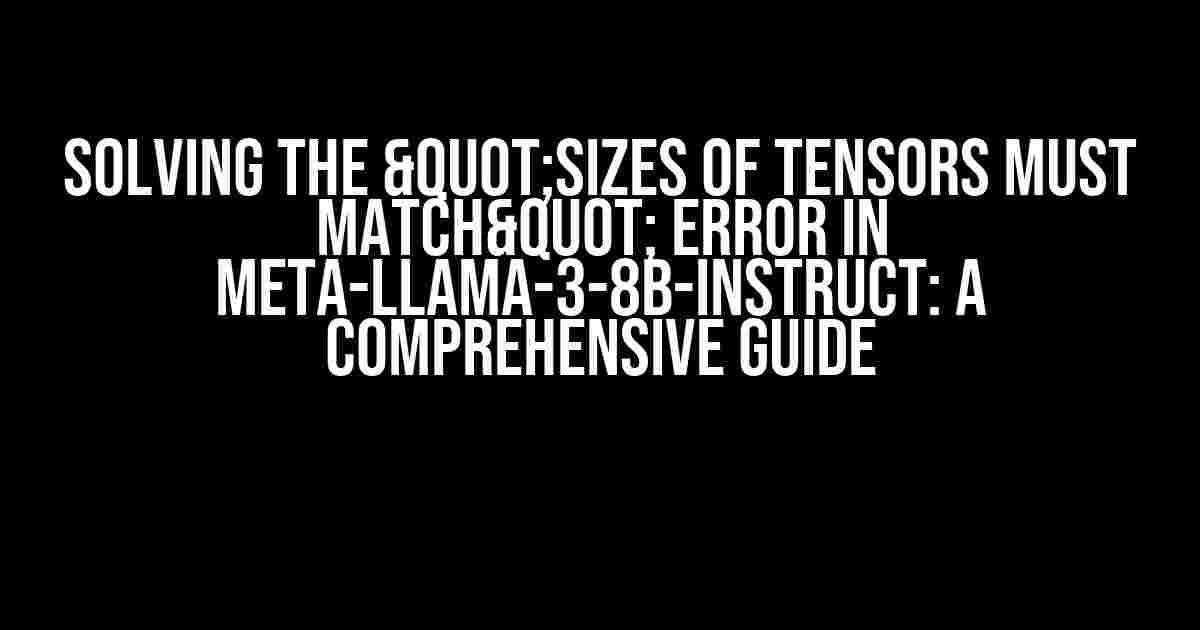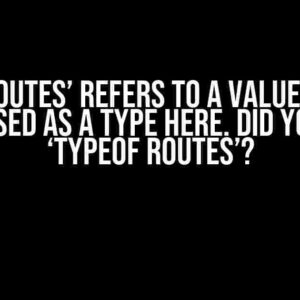Are you tired of encountering the frustrating "Sizes of tensors must match" error while working with Meta-Llama-3-8B-Instruct? You’re not alone! This error can be a major roadblock in your AI development journey, but fear not, dear reader, for we’ve got you covered. In this article, we’ll delve into the world of tensor sizes, explore the common causes of this error, and provide step-by-step solutions to get you back on track.
What are tensors, and why do their sizes matter?
In the realm of artificial intelligence, tensors are multi-dimensional arrays used to represent complex data structures. Think of them as matrices on steroids! Tensors are essential in deep learning models, such as Meta-Llama-3-8B-Instruct, as they enable efficient computation and data representation.
The size of a tensor refers to its dimensions, which can be thought of as the number of rows, columns, and additional axes. In Meta-Llama-3-8B-Instruct, tensors are used to process input data, model weights, and intermediate results. When tensors are mismatched in size, it can lead to errors, as the model expects specific dimensions to perform computations correctly.
Common Causes of the "Sizes of tensors must match" Error
Before we dive into the solutions, let’s explore the common culprits behind this error:
- Data Mismatch: Input data and the model’s expected input size don’t match.
- Model Configuration: The model’s architecture or configuration is incorrect, leading to tensor size mismatches.
- Device Incompatibility: The model is trying to run on a device (e.g., GPU or CPU) that doesn’t support the required tensor sizes.
- Version Incompatibility: Different versions of Meta-Llama-3-8B-Instruct or its dependencies can cause tensor size inconsistencies.
Solutions to the "Sizes of tensors must match" Error
Now that we’ve identified the common causes, let’s tackle each solution step-by-step:
Solution 1: Verify Input Data and Model Configuration
Double-check your input data and model configuration to ensure they match the expected sizes:
# Check input data shape
input_data.shape
# Check model configuration
model.config
Adjust your input data or model configuration accordingly to ensure they align.
Solution 2: Check Device Compatibility
Ensure your device is compatible with the required tensor sizes:
# Check device capabilities
import torch
torch.cuda.device_capability()
# Check tensor sizes on the device
tensor_size = model.tensor_size
device_tensor_size = torch.cuda.tensor_size(tensor_size)
If your device is incompatible, consider using a different device or optimizing your model for the available device.
Solution 3: Update Meta-Llama-3-8B-Instruct and Dependencies
Ensure you’re running the latest version of Meta-Llama-3-8B-Instruct and its dependencies:
# Update Meta-Llama-3-8B-Instruct
pip install --upgrade meta-llama-3-8b-instruct
# Update dependencies
pip install --upgrade transformers torch
Restart your environment and try running your model again.
Solution 4: Convert Tensors to Compatible Sizes
In some cases, you might need to convert tensors to compatible sizes manually:
# Convert tensor to compatible size
import torch
tensor = torch.randn(1, 128, 128) # Original tensor
compatible_tensor = tensor.view(1, 128, 128, 1) # Convert to compatible size
Use the `view()` method to reshape tensors to the required sizes.
Best Practices to Avoid the "Sizes of tensors must match" Error
To avoid encountering this error in the future, follow these best practices:
- Verify input data and model configuration before running your model.
- Use the correct device compatible with your model’s requirements.
- Keep your Meta-Llama-3-8B-Instruct and dependencies up-to-date.
- Use tensor conversion methods when necessary to ensure compatibility.
- Test your model with sample data before running it on large datasets.
Conclusion
The "Sizes of tensors must match" error can be a frustrating obstacle in your AI development journey. However, by understanding the common causes and applying the solutions outlined in this article, you’ll be well on your way to resolving this issue. Remember to follow best practices to avoid encountering this error in the future. Happy coding!
| Solution | Description |
|---|---|
| Verify Input Data and Model Configuration | Check input data and model configuration to ensure they match the expected sizes. |
| Check Device Compatibility | Ensure the device is compatible with the required tensor sizes. |
| Update Meta-Llama-3-8B-Instruct and Dependencies | Update Meta-Llama-3-8B-Instruct and its dependencies to the latest version. |
| Convert Tensors to Compatible Sizes | Manually convert tensors to compatible sizes using the `view()` method. |
Frequently Asked Question
Get answers to your burning questions about the “Sizes of tensors must match” error in Meta-Llama-3-8B-Instruct!
What is the “Sizes of tensors must match” error in Meta-Llama-3-8B-Instruct?
This error occurs when the dimensions of the input tensors do not match the expected dimensions of the model’s layers. It’s like trying to fit a square peg into a round hole – the model is expecting a specific shape of data, but what you’re providing doesn’t match.
Why do I get this error even when I’ve checked my input shapes?
Ah-ha! It’s possible that you’ve checked the shapes, but have you checked the batch shapes as well? Make sure the batch dimensions are aligned, or you’ll get this error. It’s like having a team of square pegs trying to fit into round holes – the batch shapes need to match too!
Can I resize my tensors to fix the error?
Yes, you can! But be careful not to lose important information. You can use techniques like padding or cropping to resize your tensors. Think of it like taking a photo of a square peg and resizing it to fit into a round hole – you need to make sure the essential parts are preserved.
How do I check the expected tensor shapes for each layer in Meta-Llama-3-8B-Instruct?
You can use the model’s documentation or the library’s built-in functions to check the expected shapes. It’s like having a map to the round hole factory – you need to know what shape of pegs they’re expecting!
Can I ignore this error and hope it goes away?
Oh no, no, no! Ignoring this error is like trying to force a square peg into a round hole and hoping it’ll magically fit. It won’t work, and you might end up with more errors or even worse, silent failures. Take the time to fix the tensor shapes, and your model will thank you!


